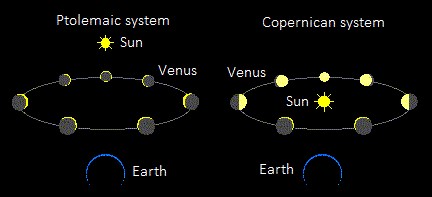The phases of Venus, 1610-23
External links
Commentary
The year 1610 also saw Galileo undertake the first series of telescopic observations of the phases of Venus. Not published until his Letter on Sunspots in 1613, these observations were every bit as disruptive of the geocentric cosmology as those published in the Sidereus nuncius of 1610.
As Galileo observed for the first time, Venus – just like the moon – goes through a full series of phases: beginning from thin crescent, it gradually waxes to a full disk and then wanes again to a crescent before disappearing altogether, after which the cycle begins again. Moreover, in its crescent phases Venus appears far larger: as it waxes, it gradually shrinks in apparent size until it reaches its full phase, after which it begins to grow in apparent size once again as it wanes.
phases of venus.png

These changes in phase and apparent size are irreconcilable with the traditional geocentric cosmology of Ptolemy: since, in the Ptolemaic system, Venus is always interposed roughly between the Earth and the Sun, the planet would only display only a very small range of phases, never exceeding a narrow sickle.
venus-geo-helio.jpg

In short, the phases of Venus provided clear, empirical evidence that Venus orbits around the Sun and not around the Earth. Although this evidence did not disprove the Tychonic system (in which the Sun and the Moon orbit around the Earth while the other planets circle the Sun), it provided devastating observational evidence against Ptolemy and his traditional supporters.
The video inserted below helps understand the nature of this demonstration. The left pane provides a representation of Venus and the Earth orbiting the Sun. The right pane provides a representation of what Venus looks like in every part of this journey when viewed from the Earth. When ‘full’, Venus is small because it at the far side from the earth on its orbit around the Sun. When ‘new’, it appear large because it is at its closest to the Earth and about to be interposed directly between the Earth and the Sun. Further explanation can be found in a video provided by the Museo Galileo.*
* To access the second video, download and play the .wmv version.
Images. Main image: Galileo, Il Saggiatore (1623), p. 217 (detail), reproduced courtesy of the History of Science Collections, University of Oklahoma Libraries; copyright the Board of Regents of the University of Oklahoma. Supplementary images: European Southern Observatory.
